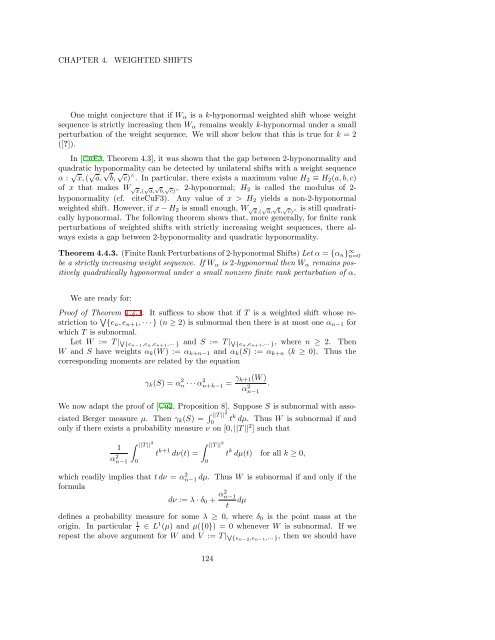Woo Young Lee Lecture Notes on Operator Theory
Woo Young Lee Lecture Notes on Operator Theory
Woo Young Lee Lecture Notes on Operator Theory
Create successful ePaper yourself
Turn your PDF publications into a flip-book with our unique Google optimized e-Paper software.
CHAPTER 4.<br />
WEIGHTED SHIFTS<br />
One might c<strong>on</strong>jecture that if W α is a k-hyp<strong>on</strong>ormal weighted shift whose weight<br />
sequence is strictly increasing then W α remains weakly k-hyp<strong>on</strong>ormal under a small<br />
perturbati<strong>on</strong> of the weight sequence. We will show below that this is true for k = 2<br />
([]).<br />
In [CuF3, Theorem 4.3], it was shown that the gap between 2-hyp<strong>on</strong>ormality and<br />
quadratic hyp<strong>on</strong>ormality can be detected by unilateral shifts with a weight sequence<br />
α : √ x, ( √ a, √ b, √ c) ∧ . In particular, there exists a maximum value H 2 ≡ H 2 (a, b, c)<br />
of x that makes W √ x,( √ a, √ b, √ c)<br />
2-hyp<strong>on</strong>ormal; H ∧ 2 is called the modulus of 2-<br />
hyp<strong>on</strong>ormality (cf. citeCuF3). Any value of x > H 2 yields a n<strong>on</strong>-2-hyp<strong>on</strong>ormal<br />
weighted shift. However, if x − H 2 is small enough, W √ x,( √ a, √ b, √ c)<br />
is still quadratically<br />
hyp<strong>on</strong>ormal. The following theorem shows that, more generally, for finite rank<br />
∧<br />
perturbati<strong>on</strong>s of weighted shifts with strictly increasing weight sequences, there always<br />
exists a gap between 2-hyp<strong>on</strong>ormality and quadratic hyp<strong>on</strong>ormality.<br />
Theorem 4.4.3. (Finite Rank Perturbati<strong>on</strong>s of 2-hyp<strong>on</strong>ormal Shifts) Let α = {α n } ∞ n=0<br />
be a strictly increasing weight sequence. If W α is 2-hyp<strong>on</strong>ormal then W α remains positively<br />
quadratically hyp<strong>on</strong>ormal under a small n<strong>on</strong>zero finite rank perturbati<strong>on</strong> of α.<br />
We are ready for:<br />
Proof of Theorem 4.4.1. It suffices to show that if T is a weighted shift whose restricti<strong>on</strong><br />
to ∨ {e n , e n+1 , · · · } (n ≥ 2) is subnormal then there is at most <strong>on</strong>e α n−1 for<br />
which T is subnormal.<br />
Let W := T | ∨ {e n−1 ,e n ,e n+1 ,··· } and S := T | ∨ {e n ,e n+1 ,··· }, where n ≥ 2. Then<br />
W and S have weights α k (W ) := α k+n−1 and α k (S) := α k+n (k ≥ 0). Thus the<br />
corresp<strong>on</strong>ding moments are related by the equati<strong>on</strong><br />
γ k (S) = αn 2 · · · αn+k−1 2 = γ k+1(W )<br />
αn−1<br />
2 .<br />
We now adapt the proof of [Cu2, Propositi<strong>on</strong> 8]. Suppose S is subnormal with associated<br />
Berger measure µ. Then γ k (S) = ∫ ||T || 2<br />
t k dµ. Thus W is subnormal if and<br />
0<br />
<strong>on</strong>ly if there exists a probability measure ν <strong>on</strong> [0, ||T || 2 ] such that<br />
1<br />
α 2 n−1<br />
∫ ||T ||<br />
2<br />
0<br />
t k+1 dν(t) =<br />
∫ ||T ||<br />
2<br />
0<br />
t k dµ(t) for all k ≥ 0,<br />
which readily implies that t dν = α 2 n−1 dµ. Thus W is subnormal if and <strong>on</strong>ly if the<br />
formula<br />
dν := λ · δ 0 + α2 n−1<br />
dµ<br />
t<br />
defines a probability measure for some λ ≥ 0, where δ 0 is the point mass at the<br />
origin. In particular 1 t<br />
∈ L1 (µ) and µ({0}) = 0 whenever W is subnormal. If we<br />
repeat the above argument for W and V := T | ∨ {e n−2,e n−1,··· }, then we should have<br />
124













